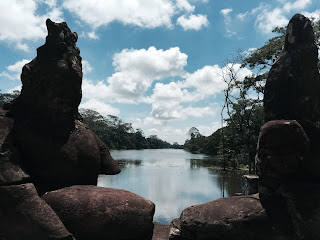One of the things we love about Ama Waterways River Cruises is the full (completely inclusive) itinerary they put on for you. With local guides at each stop to explain history and culture, you learn so much about the places you are visiting. Meanwhile, the chefs aboard are creating local delicacies for lunch and dinner - it really is a 360 degree travel experience... Following will be blog entries on each stop we made along the way: Kampong Chhnang, Ko Chen, Oudong, Kampong Tralach, Phnom Penh, Tan Chau, Sa Dec, Cai Be, My Tho, and Ho Chi Minh City.
First up, Kampong Chhnang, Cambodia...
 |
Kampong Chhnang is at the southern tip of the big lake (Tonle Sap Lake). Siem Reap is at the Northwest tip of the same lake.
Ama Dara anchored mid-stream and small local boats came out to pick up the excursion groups. Each group had their own local, English speaking guide and each guest had a small headset giving you the ability to hear your guide from 50'.
|
 |
| Ama Dara anchored mid-stream |
 |
| Boarding our boats |
 |
| Beautiful Tourists |
 |
| Leaving Ama Dara to see Floating Village |
We headed south and then turned east into a channel leading us to Kampong Chhnang. Kampong Chhnang is a combination of Floating Village and small shoreside town.
 |
| Shoreside Town |
 |
| Floating Village |
We spent most of our time taking a close look at how a floating village is built, what it is composed of, and the lives of people who spend their lives afloat.
 |
| Taxi |
So, if you live in a floating village, there has to be a floating equivalent of Uber, right? Depicted above is a mom and her son being taxied from one side of the floating village to the other.
 |
| Bamboo used to float the village homes |
The homes, stores, meeting halls, and businesses making up the float village which encompassed both banks of the river are essentially homes built in place on top of long bamboo logs that form the primary floating foundation for the homes. According to our guides, the individual bamboo logs (stalks?) are replaced every 2-3 years as they become water logged and begin to rot. You can also see the bamboo is supplemented by more modern floatation aids in the form of blue or white plastic barrels lashed under the home floors alongside the bamboo.
 |
| One of our tour boats |
 |
| Floating Main Street |
 |
| Fish are a major component of their diet |
 |
| Ferry from one side of the river to the other |
So you might ask, who are these folks who live on the river and what's their story? According to our guide, the majority of these folks are ethnic Vietnamese who have been there in many instances for more than one generation. Those born in Cambodia receive citizenship papers but as is often the case, if you are different, there is a level of prejudice present even after so many years. The reason these folks initially started living on the river is that they immigrated from Vietnam and found that living on the river was a lot cheaper than trying to buy and build a home ashore.
After a two hour two, we headed back to Ama Dara in time for lunch - and oh what a lunch...
 |
| "Action Station" |
 |
The finished product - Yuuummm
|
We started enjoying noodle soups for breakfast and lunch when we arrived in Bangkok. We are sure that having soup for breakfast and lunch aboard Ama Dara is a key reason we both lost weight for the first time on a cruise - it wasn't as if we weren't eating a ton - because we were - and enjoying every bit of it. But I think the soup just tended to fill us up and keep our appetite satisfied better than what we typically eat for breakfast and lunch here at home.
 |
| Leaving Kampong Chhnang |
 |
| Beautiful view from our sun deck cabin |
 |
| Pastoral scene along the river |
After lunch, we headed south on the river, bound for Koh Chen and our afternoon tour ashore. Koh Chen is a small village on the banks of the Mekong that is known for its silver smithing. A number of families in town have passed their craft from generation to generation - we visited one of these families and were introduced to their craftsmanship - and how to tell Sterling silver from plated silver.
 |
| Our guide Sophia explaining how things are made |
 |
| Everyone in the family has a skill |
After our visit to the silver shop, we took a walk through the village to the local elementary school. Here at the school, the teacher introduced us to the kids and our guide helped serve as an interface between the kids and cruisers. It was a really wonderful experience -- education beyond grade school is still a big deal in rural Cambodia - but these kids had a ton of enthusiasm for learning. How do you learn about cultures when you travel? You walk out into their villages and start to learn how they live, how they learn, and how they eat. This was a wonderful day starting our Cambodian education.
 |
| Class welcomes us |
 |
| Valerie talking with a rapt audience of young girls - they were able to keep up a pretty decent conversation in English - amazing to think about in a small village on the Mekong Delta. |
 |
| Good shot of the headsets we used to listen to our guide's stories. |














































































